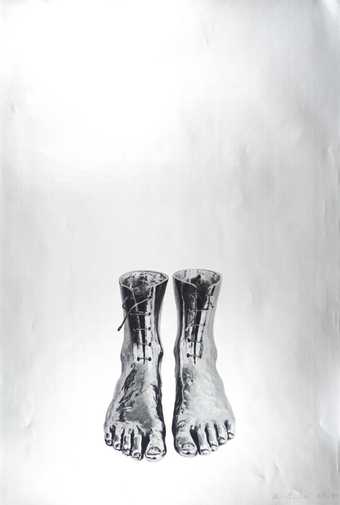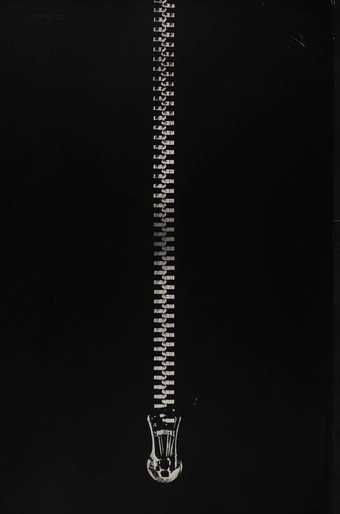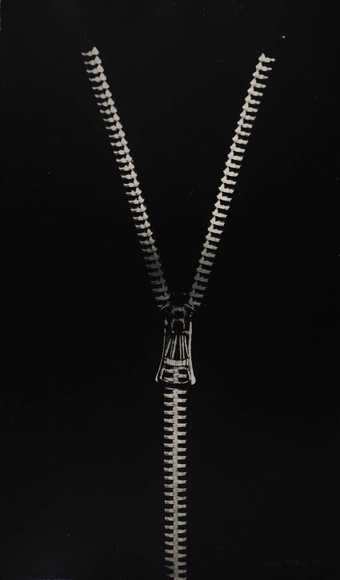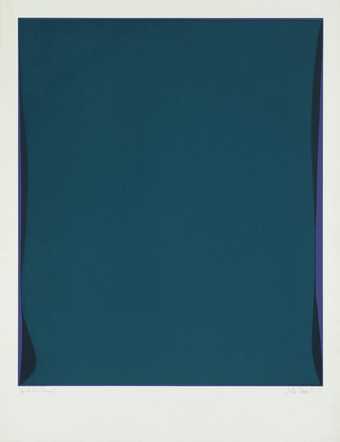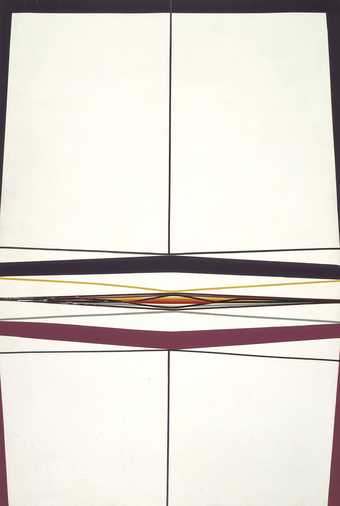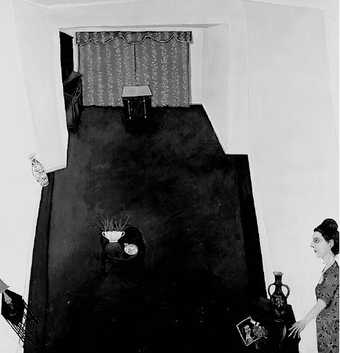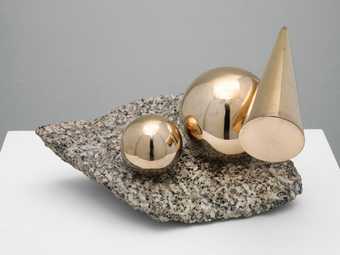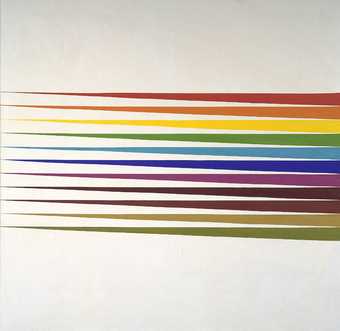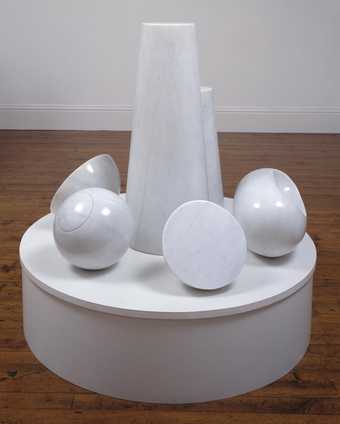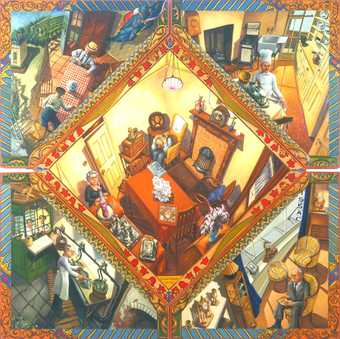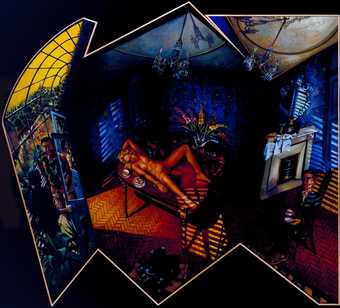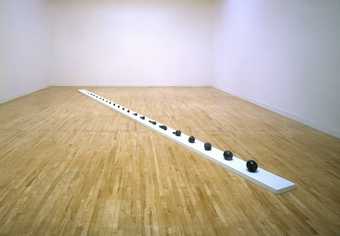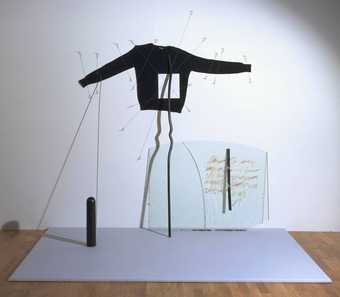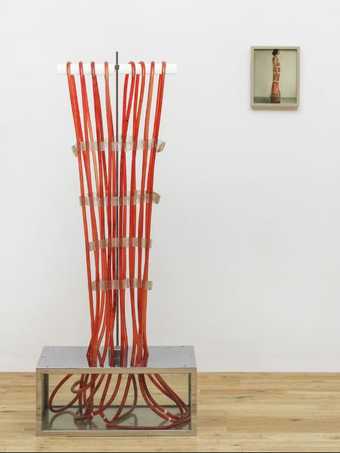
Not on display
- Artist
- Clive Barker born 1940
- Medium
- Metal on wooden base
- Dimensions
- Object: 864 × 356 × 356 mm
- Collection
- Tate
- Acquisition
- Purchased 1970
- Reference
- T01211
Display caption
This work was suggested to the artist by a row of buckets he saw outside an ironmonger?s shop, one of which had rain water in it. He bought some buckets, taps and tubing which he then covered in chrome. Barker said that at the time he was inspired by the American commercial practice of carefully arranging ordinary domestic objects in shop displays as if they were expensive.
Gallery label, May 2003
Does this text contain inaccurate information or language that you feel we should improve or change? We would like to hear from you.
Catalogue entry
Clive Barker born 1940
T01211 Splash 1967
Not inscribed.
Chrome and nickel-plated metal, wooden base and ball bearings, 34 x 14 x 14 (86.4 x 35.6 x 35.6).
Purchased from the Robert Fraser Gallery (Gytha Trust) 1970.
Coll: Purchased by Robert Fraser from the artist 1967.
Exh: British Artists: 6 Painters, 6 Sculptors, Museum of Modern Art exhibition touring the U.S.A., July 1967–October 1968 (no catalogue number, repr.); Robert Fraser Gallery, January 1968 (4); Group Show, Robert Fraser Gallery, May 1968 (2).
Lit: Christopher Finch, ‘Clive Barker’ in Art and Artists, II, January 1968, pp. 16–19,repr- P.17 ; Christopher Finch, Image as Language, 1969, pp. 134–42, repr. pi. 68.
The artist told the compiler (13 March 1972): ‘I am concerned in my work to disguise familiarity. I see the buckets as the logical extension of the Van Gogh chair series. On that occasion I took a well-known pictorial image, and transformed it by- making a chrome model of it. But I do not always acquire my objects from art. I am equally inspired by just driving along a street, going into a sweetshop, seeing a waitress carrying a tray with knives and forks on it.
‘I started making objects in 1962. The early works were of leather: after incorporating chrome in “Tribute to Jim Dine” in 1964 I have worked generally in chrome.
‘In March 1967, I saw a row of buckets outside an ironmongers in Kilburn Road. One of the buckets had rain water in it. At first I thought of making a piece comprising a line of 6 to 10 chrome buckets. However, I bought only two or three buckets, costing 8/1d each, and some tubing and taps from the shop. I made three “bucket” works. The first was “Bucket of Raindrops” (coll. Bill Copley, New York). This is a partially chromed bucket and ball bearings on a wooden base. The success of this work encouraged me to make two further buckets, “Drips” (coll. Robert Meyer, New York) and “Splash”. In “Drips” a tap is fixed to a vertical chromed sheet which is attached to the back of the base. I had planned that in “Splash” the fluted metal tube representing the stream of water would support the tap, and that the end of the tap pipe would be placed against the wall. It would seem to come from the wall and thus appear more realistic. However, after attaching the back plate in “Drips”, I decided to incorporate the same element for “Splash”. I also realised that the back plate helped to present the tap and bucket as an object, distinct from their ordinary equivalents. In this piece I was interested to take a cheap 8/1d metal bucket and transform it. The interest was partly stimulated by what I saw at the Vauxhall Car factory’ (where he worked as a leather fitter 1960–1). ‘Badly galvanised metal is altered into beautifully produced sleek bonnets. I also remember the large tips full of gleaming chrome car parts.
‘It cost about £15 to have the bucket dipped in chrome. There were between nine and twelve processes, acid baths, stripping etc; I was interested that the transformation of the bucket could only occur through a long series of operations. I have my pieces chromed at the Juno Plating Co., South End. The size of the usual chrome baths, which cannot take any object larger than 3 ft. and the weight of the acid, have determined the dimensions of my works. [Up to 1971, he had not made any sculpture larger than 3 ft.]. This year I am working on a sofa which is 8 ft. long. I think the weight of the acid may be too great.
‘A particular feature of the bucket series is that it was the only occasion that I had ready made objects chromed. Usually I make the objects in brass, steel, copper and then have them dipped.’
‘Splash’ was made after his first visit to the United States in 1966. He commented: ‘I do not think that I was especially influenced by American Art. I saw and like the chrome objects by Trova and admired the work of Jasper Johns and Tom Wessel- mann but what struck me however, especially in New York, was the American commercial activity of displaying and packaging expensively even the most ordinary domestic objects. I was rather amused by this.
‘After buying the buckets, I made a number of small rough sketches— then when “Splash” was finished I drew it with pen and brush [Clive Barker often produces prints or silkscreen prints of his objects]. I was interested in the white and black appearance, chrome appearing as white, the reflections as black.’ (The drawings are still in the artist’s collection).
Published in The Tate Gallery Report 1970–1972, London 1972.
Explore
- objects(23,571)
-
- miscellaneous(732)
-
- tap(10)
- vessels and containers(2,157)
-
- bucket(111)
You might like
-
Clive Barker Homage to Magritte
1969 -
Clive Barker Zip I
1965 -
Clive Barker Zip II
1965 -
John Plumb Bermuda
1965 -
John Plumb Edgehill
1962 -
Anthony Green Souvenir de Jeunesse: Madeleine Joscelyne’s Lounge
1967 -
Marlow Moss Balanced Forms in Gunmetal on Cornish Granite
1956–7 -
John Plumb Untitled August 1969
1969 -
Dame Barbara Hepworth Fallen Images
1974–5 -
Anthony Green Casimir Dupont
1980 -
Anthony Green L’Heure du Thé, Argenton-sur-Creuse
1980 -
Sir Antony Gormley OBE RA Natural Selection
1981 -
Hubert Dalwood Lucca
1958 -
Martin Naylor Discarded Sweater
1972–3 -
Rebecca Horn Overflowing Blood Machine
1970

